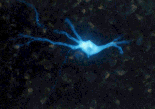| Sponsored by Wake Forest University School of Medicine and National Families in Action | |||
| Glossary - N | |||
| This glossary comes from False Messengers: How Addictive Drugs Change the Brain, by David Friedman, PhD, and Sue Rusche, Harwood Academic Publishers, Amsterdam, The Netherlands, 1999. A
| B | C
| D | E
| F | G
| H | I
|
|
|||
| N Naltrexone A long-lasting opiate antagonist used for the treatment of heroin addiction, and more recently used for the treatment of alcohol addiction. Negative reinforcement Reward generated by the removal of painful or stressful conditions or events. Nembutal (pentobarbital) A depressant drug of the barbiturate family used to induce sleep. Neural substrate The set of brain structures that underlies specific behaviors or psychological states. Neurochemicals Neurotransmitters and other brain chemicals produced by neurons. Neuron Nerve cell. Neurons are unique cells found in the brain and body that are specialized to process and transmit information. Neuroscience The study of how the brain and nervous system work. Neuroscience integrates more traditional scientific approaches such as anatomy, physiology, and biochemistry, along with newer fields such as molecular biology and computer science, to understand how the nervous system functions. Neurotoxins Substances that damage or kill neurons. Neurotransmission The process that occurs when a neuron releases neurotransmitters to communicate with another neuron across the synapse. Neurotransmitter Chemicals produced by neurons to carry their messages to other neurons. |
|
Nicotine The drug in tobacco that is addictive. Nicotine also activates a specific kind of acetylcholine receptor. Nicotine gum, nicotine patch Two methods of delivering small amounts of nicotine into the bodies of people who are addicted to nicotine to help them quit smoking cigarettes by preventing nicotine withdrawal. Nicotinic cholinergic receptor One of two acetylcholine receptors. This one responds to nicotine as well as acetylcholine. Nitrous oxide An inhalant, also known as "laughing gas." Nitrous oxide is a weak anesthetic that does not produce unconsciousness. Norepinephrine A neurotransmitter and a hormone. It is released by the sympathetic nervous system onto the heart, blood vessels, and other organs and by the adrenal gland into the bloodstream as part of the fight-or-flight response. Norepinephrine is also present in the brain and is used as a neurotransmitter in normal brain processes. Nucleus A cluster or group of nerve cells that is dedicated to performing its own special function(s). Nuclei are found in all parts of the brain except the cerebral cortex, where such groups are called cortical fields. Nucleus accumbens A part of the brain reward system, located in the limbic system, that processes information related to motivation and reward. It is the key brain site where virtually all drugs of abuse act to reinforce drug taking. |
|
| Home | For Journalists | For the States | Science Update | Links | Glossary | About |
Last Revision
info@addictionstudies.org

